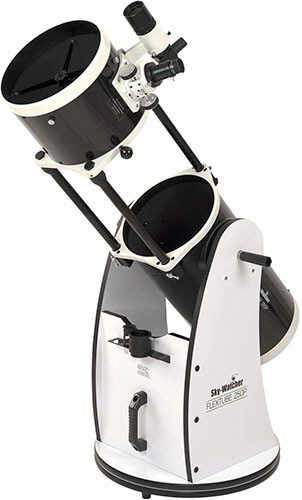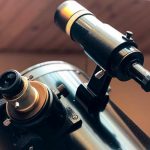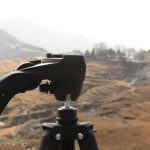Best Telescope Under $1000
Do you want to find the best telescope under $1000? You can buy yourself an excellent telescope for this kind of money that will enable you to view deep sky objects such as galaxies and nebula and the planets and, of course, our moon. It’s also a great price point because it’s a good balance between the quality of the instrument you get without worrying too much about the cost.
However, you’re going to find masses of options at this price that might rack up the confusion levels. I’m not saying that for everybody; of course, you might have plenty of experience with telescopes and know precisely what you want.
But for those who might be a little unsure what the best telescope is for under $1000, this guide will certainly point you in the right direction.
So, let’s get things underway with our list of the best telescopes under $1000.

Our Top 3 Best Telescopes Under $1000
1. Sky-Watcher Flextube 250 Dobsonian 10-inch Collapsible Large Aperture Telescope
Unsurprisingly many people new to amateur astronomy opt for a cheap telescope, only to be disappointed with the viewing results. The Sky-Watcher Flextube 250 Dobsonian 10-inch telescope is one of those you buy when you realize unless you spend a decent amount of money, you aren’t going to get what you want from stargazing.
With the Sky-Watcher Flextube 250, you can buy an 8-inch or 10-inch aperture model; however, we highly recommend spending a little more and getting the 10-inch aperture. You won’t regret the purchase for the extra money when you see the view you can achieve.
As long as you have the storage space available, because this Dobsonian telescope is big and hefty, then you’ll appreciate the f/5.0 focal ratio provided by the telescope’s 10-inch aperture and 1200mm tube. However, it does have an innovative collapsible tube design, which helps reduce the amount of space it will need; even though the tube collapses for helpful portability, it will maintain collimation.
The telescope will come to you in two boxes, the tube in one and the Dobsonian base in the other. Being a Dobsonian, the base is heavy and does require putting together. Once you have everything assembled, the first time out, you’ll need to collimate the telescope.
You’ll also need to add a Barlow lens because the telescope doesn’t come with a free one; having a Barlow lens will help you see Jupiter and Saturn, plus many other night sky objects. The accessories you get with the telescope include a 2-inch Crayford style focuser with one 1/4-inch adapter, two super wide-angled eyepieces (25mm and 10mm), and an 8×50 right-angle finder scope.
The Sky-Watcher 250 Dobsonian is a beautiful collapsible optical tube with a large 10-inch aperture yet a portable design.
Dobsonians typically give astronomers a lot of aperture for the money they pay; however, portability can be a significant detrimental factor because of the size and weight of large reflector telescopes. The Sky-Watcher’s unique collapsible solves this issue.
Why We Like It: The Sky-Watcher 250 incorporates a patented tension control handle for precise aiming and slewing, plus the collapsible optical tube.
Key Features:
- Requires collimation before first use
- Collapsible optical tube
- 10-inch aperture
- Works well in light-polluted areas
- 94% reflectivity
- Patented tension control handle
- Telescope comes with accessories
- Teflon bearings for smooth azimuth movement
2. Celestron – NexStar 5SE Telescope
If you’re looking for a highly portable computerized telescope in the $1000 range, then the NexStar 5SE is what you need whether you’re a beginner or have some experience under your belt. The 5-inch aperture doesn’t gather as much light as its big brothers, the 6 and 8 SE. But as we said, if portability is your aim, this is the telescope to opt for.
Assembling the Celestron 5SE is very straightforward; the single fork arm design and robust steel tripod all come as separate components. When you assemble the telescope for use, the SkyAlign technology will have you aligned and sorted in no time.
Computerized tracking is an intelligent system for finding fainter deep sky objects in the night sky. However, the motor requires eight AA batteries, and these get used up pretty rapidly, especially if you do a lot of tracking. I suggest you get another power source that doesn’t burn through batteries, like a portable lithium-ion power bank.
The fully-automated Go To mount features 40,000 celestial objects that it automatically locates and tracks, perfect for beginners who might struggle with trying to find deep space objects when new to the hobby. Once everything is set up and you’ve entered your exact location and time, etc., you’re ready to view the night sky. To Find galaxies, nebulae and planets is simple with the 5SE because the telescope does everything for you.
If astrophotography is your thing, then this is not the telescope for you; however, that doesn’t stop you from taking images off what you’re viewing. You can accomplish this in several ways, but I think buying a phone adapter and using the telescope with your smartphone is the simplest way.
Celestron has designed this telescope so that owners can easily transport it into the field with them if they need to look for darker skies with less light pollution. The 5SE is perfect for taking on camping or RV trips.
As an added bonus, when you buy the 5SE telescope, you get to download an excellent astronomy software program for an interactive sky simulation.
Why We Like It: The 5SE utilizes SkyAlign alignment technology ideal for beginners and even experienced astronomers.
Key Features:
- Schmidt-Cassegrain
- Aperture: 5-inch
- Focal length: 1250 mm (49”)
- Single Fork Arm Altazimuth Mount
- Focal ratio: f/10
- Magnification: 50x
- SkyAlign technology
- Includes 40,000 celestial objects
- Lots of accessories
- Reliable and well made GoTo mount
3. Sky-Watcher EvoStar ProEd 80 APO Doublet Refractor
We talked in the last review about astrophotography, and while the reviewed telescopes are capable of taking beautiful images of what you’re viewing, that’s not astrophotography. But what if you’re looking for a telescope specifically for astrophotography? Well, in that case, we highly recommend the Sky-Watcher EvoStar 80 APO Doublet Refractor.
This telescope is an entry-level APO telescope. APO is short for apochromat and means undetectable amounts of chromatic aberration (a purple haze surrounds viewed objects). All refractor lenses suffer from chromatic aberration, unlike reflector telescopes that use mirrors. An apo telescope uses fluorite-based lenses as a doublet, as with this Skywatcher EvoStar 80, or a triplet objective.
The EvoStar 80 offers brilliant color correction by utilizing the finest quality glass and metallic high-transmission coatings (MHTC). The result is accurate color, undetectable color aberrations, and pinpoint sharp images.
With the previous telescopes, we recommended much larger apertures and while you might be thinking 80mm is a small aperture, in comparison, there’s more than enough for astrophotography.
Astrophotography involves taking long exposure images and using specific software programs to stack the pictures together.
The ProEd has a focal ratio, or speed of the telescope’s optics, of f/7.5. You get to this “speed” by dividing the focal length by the aperture. The focal ratio is crucial for astrophotography.
A long focal length provides higher magnification and a narrower field of view, which isn’t what you need for astrophotography. You want more expansive views that take in the Milky Way, galaxies, or star clusters; for this, you need a lower focal ratio, such as the f/7.5 of this telescope.
With this telescope, you can take fantastic wide-field images of the sky. You might not be able to see deep sky objects with your eyes, but when you see them through a telescope, it will amaze you just how enormous they are. Having a short focal length is pretty much essential for exceptional wide-field deep-sky object photography.
Should you feel more magnification is necessary, you can add a Barlow lens to your collection and double or triple the viewing power of your telescope.
Irrespective of the eyepiece or camera, you choose to use the 10:1 dual-speed Crayford-style focuser means you’ll find focus very quickly.
The accessories that come with your purchase are also excellent and include a foam-lined aluminum hard case, 8×50 right angle correct image finderscope, dielectric diagonal, 5mm and 25mm LET eyepieces, 1.25″ adapter, mounting rings, and a V-style dovetail.
Why We Like It: The ProEd 80 is a fantastic entry-level astrophotography telescope that’s small and portable enough to take anywhere.
Key Features:
- Excellent price point
- Perfect for astrophotography beginners
- Straightforward and quick to assemble
- Lightweight and portable
- Plenty of accessories included
- 10:1 dual-speed focuser
- Outstanding color correction
- Extra low dispersion glass
- f/7.5 focal ratio
- 600mm focal length
- APO doublet optical design
Final Thoughts
With our guide to the best telescope under $1000, you should have a good idea of what’s available for your chosen price point. There’s a lot to think about and understand when it comes to telescopes, and sometimes it is best to test out the models you have in mind. Assuming that’s possible for you.
My advice is to think about your priorities and what you want the telescope to offer you. Do you want to get into astrophotography? Gaze at deep-sky objects? Or get as close up to the moon and the planets? Will you be using the telescope in a fixed position, say in your backyard, or do you need a portable telescope to take out into the field?
Make sure you take a look at our reviews and buying guides for telescopes under $300 and $100.




















